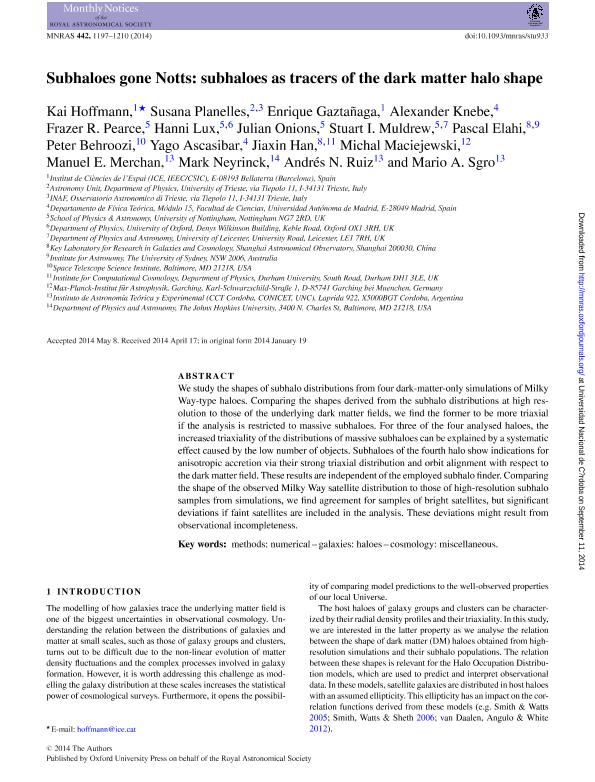Artículo
Subhaloes gone Notts: subhaloes as tracers of the dark matter halo shape
Hoffmann, Kai; Planelles, Susana; Gaztañaga, Enrique; Knebe, Alexander; Pearce, Frazer R.; Lux, Hanni; Onions, Julian; Muldrew, Stuart I.; Elahi, Pascal; Behroozi, Peter; Ascasibar, Yago; Han, Jiaxin; Maciejewski, Michal; Merchan, Manuel Enrique ; Neyrinck, Mark; Ruiz, Andrés Nicolás
; Neyrinck, Mark; Ruiz, Andrés Nicolás ; Sgró, Mario Agustín
; Sgró, Mario Agustín
 ; Neyrinck, Mark; Ruiz, Andrés Nicolás
; Neyrinck, Mark; Ruiz, Andrés Nicolás ; Sgró, Mario Agustín
; Sgró, Mario Agustín
Fecha de publicación:
08/2014
Editorial:
Wiley Blackwell Publishing, Inc
Revista:
Monthly Notices of the Royal Astronomical Society
ISSN:
0035-8711
Idioma:
Inglés
Tipo de recurso:
Artículo publicado
Clasificación temática:
Resumen
We study the shapes of subhalo distributions from four dark-matter-only simulations of Milky Way-type haloes. Comparing the shapes derived from the subhalo distributions at high resolution to those of the underlying dark matter fields, we find the former to be more triaxial if the analysis is restricted to massive subhaloes. For three of the four analysed haloes, the increased triaxiality of the distributions of massive subhaloes can be explained by a systematic effect caused by the low number of objects. Subhaloes of the fourth halo show indications for anisotropic accretion via their strong triaxial distribution and orbit alignment with respect to the dark matter field. These results are independent of the employed subhalo finder. Comparing the shape of the observed Milky Way satellite distribution to those of high-resolution subhalo samples from simulations, we find agreement for samples of bright satellites, but significant deviations if faint satellites are included in the analysis. These deviations might result from observational incompleteness.
Palabras clave:
Methods: Numerical
,
Galaxies: Haloes
,
Cosmology: Miscellaneous
Archivos asociados
Licencia
Identificadores
Colecciones
Articulos(IATE)
Articulos de INST.DE ASTRONOMIA TEORICA Y EXPERIMENTAL
Articulos de INST.DE ASTRONOMIA TEORICA Y EXPERIMENTAL
Citación
Neyrinck, Mark; Behroozi, Peter; Lux, Hanni; Onions, Julian; Elahi, Pascal; Gaztañaga, Enrique; et al.; Subhaloes gone Notts: subhaloes as tracers of the dark matter halo shape; Wiley Blackwell Publishing, Inc; Monthly Notices of the Royal Astronomical Society; 442; 2; 8-2014; 1197-1210
Compartir
Altmétricas



